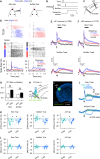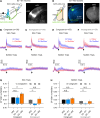This is a preprint.
Perceptual choice and motor signals in mouse somatosensory cortex
- PMID: 39713341
- PMCID: PMC11661076
- DOI: 10.1101/2024.12.06.627272
Perceptual choice and motor signals in mouse somatosensory cortex
Abstract
Somatosensory cortex activity relates both to sensation and movement, reflecting their intimate relationship, but the extent and nature of sensory-motor interactions in the somatosensory cortex remain unclear. Here, we investigated perception-related sensory and motor signals in the whisker areas of mouse primary (wS1) and secondary (wS2) somatosensory cortices. We recorded neuronal activity while mice performed a whisker detection task using two alternative lickports, one each to indicate the presence or absence of a whisker deflection on a given trial. One group of mice reported the presence of the whisker stimulus by licking at the port on the same ("congruent") side of the animal as the stimulated whisker, whereas a second group of mice did so by licking at the opposite ("incongruent") side. Activity of single neurons in wS1 and wS2 correlated with perceptual choice. This choice-related activity was enhanced when responding to the congruent side. wS2 neurons projecting along two output pathways-to wS1 or to whisker secondary motor cortex, wM2-also showed choice-related activity, but differed in their dependence on congruence and in the effects of optogenetic manipulation. Thus, somatosensory cortex contains pathway- and action-specific choice-related activity.
Figures




Similar articles
-
Interareal Synaptic Inputs Underlying Whisking-Related Activity in the Primary Somatosensory Barrel Cortex.J Neurosci. 2024 Jan 24;44(4):e1148232023. doi: 10.1523/JNEUROSCI.1148-23.2023. J Neurosci. 2024. PMID: 38050130 Free PMC article.
-
Projection-specific Activity of Layer 2/3 Neurons Imaged in Mouse Primary Somatosensory Barrel Cortex During a Whisker Detection Task.Function (Oxf). 2020 Jul 2;1(1):zqaa008. doi: 10.1093/function/zqaa008. eCollection 2020. Function (Oxf). 2020. PMID: 35330741 Free PMC article.
-
A Non-canonical Feedback Circuit for Rapid Interactions between Somatosensory Cortices.Cell Rep. 2018 May 29;23(9):2718-2731.e6. doi: 10.1016/j.celrep.2018.04.115. Cell Rep. 2018. PMID: 29847801 Free PMC article.
-
Neuronal Circuits in Barrel Cortex for Whisker Sensory Perception.Physiol Rev. 2021 Jan 1;101(1):353-415. doi: 10.1152/physrev.00019.2019. Epub 2020 Aug 20. Physiol Rev. 2021. PMID: 32816652 Review.
-
Cortical control of whisker movement.Annu Rev Neurosci. 2014;37:183-203. doi: 10.1146/annurev-neuro-062012-170344. Epub 2014 May 9. Annu Rev Neurosci. 2014. PMID: 24821429 Review.
References
-
- Sachidhanandam S., Sreenivasan V., Kyriakatos A., Kremer Y. & Petersen C. C. H. Membrane potential correlates of sensory perception in mouse barrel cortex. Nat. Neurosci. 16, 1671–1677 (2013). - PubMed
-
- Oryshchuk A. et al. Distributed and specific encoding of sensory, motor, and decision information in the mouse neocortex during goal-directed behavior. Cell Rep. 43, 113618 (2024). - PubMed
Publication types
Grants and funding
LinkOut - more resources
Full Text Sources
